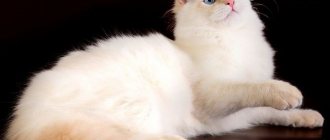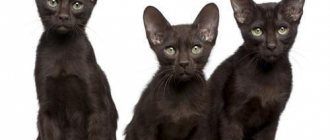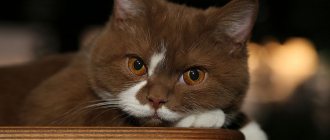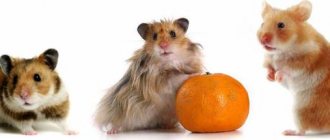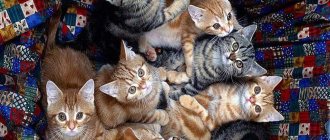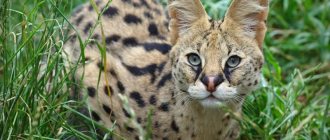Russian Kote
- Fact 1:
The Don Sphynx is one of the most exotic breeds bred by Russian breeders - Fact 2:
The Karelian Bobtail is a Russian aboriginal breed, bred in St. Petersburg in the 80s. last century. - Fact 3:
The Kurilian Bobtail is another breed that belongs to the aboriginal group. - Fact 4:
Russian Blue is one of the oldest breeds bred in Russia. Mentions of it date back to the reign of Catherine II.
Cats have been constant companions of humans for many centuries. In some countries they were considered sacred and inviolable, and were valued more than gold. In case of natural disasters or danger, they tried to save them first.
In other cultures, cats were only household guards against rodents or small predators. Sailors loved these pets very much. They often took cats on long voyages to protect food supplies from rats.
In Russia, cats have been revered for a long time. This is the only animal that is not prohibited from appearing in the temple. Nowadays, graceful pets, like many centuries ago, are credited with many wonderful properties: the ability to heal diseases and foresee disasters. Indeed, after caressing a purring friend or stroking soft fur, you can forget about all your problems.
Development of felinology in Russia
The most popular breeds of Russian cats are:
- Siberian;
- Neva Masquerade;
- Kurilian and Karelian bobtail;
- Ural rex;
- Russian blue and others.
Cat breeding began more than three centuries ago. But felinology reached its real flourishing only at the end of the 20th century. At this time, active work began to create new breeds or improve the qualities of existing ones. Specialists had the opportunity to exchange experiences with colleagues from other countries. Cats bred by Russian breeders are not inferior to foreign ones either in external qualities or in character.
Don Sphynx
The Don Sphynx is one of the most exotic breeds bred by Russian breeders. It is considered hypoallergenic, so it is ideal for anyone who is allergic to cat hair.
Don Sphynxes have a rather specific appearance:
- massive body;
- gray-blue skin;
- abundant folds on the face, neck and legs;
- very large ears;
- long limbs and tail.
The peculiarity of the breed is its tightly clenched toes, similar to those of humans.
The character of the Don Sphynx is dominated by such qualities as playfulness and independence. They are very smart and quick-witted. But due to excessive independence, they are not very trainable.
Despite their exotic appearance, Don Sphynxes are popular due to their hypoallergenicity and ability to rid their owners of negative energy. It is believed that cats relieve excessive nervous tension, fatigue, headaches and symptoms of certain diseases.
Karelian Bobtail
The Karelian Bobtail is a Russian aboriginal breed bred in St. Petersburg in the 80s. last century. Its ancestors are considered to be Norwegian forest cats. Thanks to this, modern fluffies look very similar to wild animals.
Karelian Bobtails are different:
- the gracefulness of wild cats;
- a short fluffy tail resembling a pompom (its shape can be straight or curved);
- thick hair;
- expressive blue or green eyes;
- strong but not coarse build.
The Karelian Bobtail is easy to care for. Easily adapts to life both in a private house and in a city apartment. The nature of cats is dominated by independence and self-reliance. They don't require much attention. Therefore, people who spend little time at home can safely get such pets. Another advantage of the breed is taciturnity. Cats do not have the habit of annoying their owners with loud meows at the most inopportune times.
Shorthair nutrition
As for the organization of nutrition for short-haired cats, this does not require compliance with any specific rules. Regardless of the type of fur, the cat remains an obligate carnivore, and the basis of its diet should be animal products.
The cat's diet should be tailored to its age and physical activity. A balanced diet is the key to good health and long life. You can choose a good dry food among the premium, superpremium and holistic options, paying attention to the percentage of meat content and the manufacturer’s recommendations on the packaging.
It is a little more difficult to create your pet’s diet from natural products on your own, but some picky cats are much more willing to eat such food. It is important here not to confuse natural food with “food from the table” - no soups, cutlets, sausages, cheeses, sweets and other components of the human diet are suitable for cats and are extremely harmful to their health.
In addition, when feeding natural food, it is better to regularly give the cat fortified supplements with taurine and biotin, since natural food usually does not contain enough of these ingredients for the animal.
Cats with short hair are much less likely to have digestive problems associated with the accumulation of hair in the stomach, whereas this happens very often with their long-haired relatives. And yet, it is useful to regularly give them young grass (sprout oats, rye, wheat) or wool-producing treats to improve peristalsis.
Kurilian Bobtail
The Kurilian Bobtail is another breed that belongs to the aboriginal group. A distinctive feature is a fluffy and short pom-pom tail.
Cats have a bright and memorable appearance:
- strong and compact build;
- powerful legs, heavily covered with hair;
- a lush mane on the neck and abundant fur throughout the body;
- a muzzle with the features of a wild animal;
- wide powerful cheekbones;
- piercing look.
There are two varieties of the breed – shorthaired and semi-longhaired. The color can be varied. The standard does not allow such colors as chocolate, lilac, cinnamon, fawn.
Kurilian Bobtails not only have an original appearance, but also a unique character. In behavior and type of temperament, they are more like dogs. Cats of this breed are very loyal to their owners and very obedient. Only one person is considered the owner. They treat other family members calmly and friendly. Their easy-going nature allows them to coexist peacefully with other pets, even dogs.
Bombay cat
The Bombay cat with black short silky hair, shiny blue eyes, and a large build resembles domestic panthers in appearance (see large cat breeds). This cat breed is considered rare, but they have a reputation as a favorite for their exotic appearance and wonderful personality.
Bombay cats even have black pads on their paws and nose. The Bombay breed was developed by breeder Nikki Horner. They reminded her of the Indian leopard, so she gave them the peculiar name Bombay, after the city in India.
There are two known varieties of the breed - American and British Bombay. Their disposition is affectionate and mischievous. They are very active and playful, so they get along well with children.
He loves all family members, but chooses the owner herself and literally follows on his heels. He cannot stand loneliness and constantly requires increased attention.
Neva Masquerade
A young breed that was bred only at the end of the last century. It received its name from its place of origin (St. Petersburg) and because of its color characteristics. Dark hairs grow on the face, reminiscent of a masquerade mask. These cats have very thick and long hair. Especially lush on the chest, tail and hind legs.
Neva Masquerade Dogs are distinguished not only by their beautiful appearance, but also by their wonderful character. They:
- sociable;
- unobtrusive;
- smart;
- loyal to their owners;
- absolutely unforgiving.
Thanks to their high level of intelligence, cats quickly get used to their name. Having remembered the nickname, they do not respond to any other calls, especially from strangers. Neva Masquerade Dogs are very friendly. They get along well with other pets - cats or dogs.
Egyptian Mau
The Egyptian Mau is a descendant of the cats of Ancient Egypt. Short coat, compact body and large almond-shaped eyes. Their distinctive feature is the “scarab” pattern on the face and “makeup”.
Makeup refers to a couple of lines running under the eyes. These cats attract attention due to their coloring. They can be smoky, silver or bronze in color.
Their spotted color was reminiscent of the ancient Egyptian relief, and the similarity with the sacred cats of Ancient Egypt and the original name make our imagination about these maus exciting. They were very revered in Ancient Egypt, they were compared to deities, for the murder of which they were sentenced to death.
For a long time, Egyptian cats were found only in their homeland, and only in the 50s were they first noticed in the USA. Even the Russian princess Trubetskoy was the owner of these cats, brought to her from Egypt itself.
Petersburg Sphinx, or Peterbald
Another breed with an exotic appearance. These cats have a completely naked body without a single hair, huge ears, thin and long legs and a tail. Despite their very specific appearance, they are very popular. Peterbalds have a wonderful character.
They:
- playful;
- smart;
- loyal to owners;
- friendly towards both people and animals.
St. Petersburg Sphynxes love children. They allow themselves to be stroked and picked up. They treat all family members equally well.
Russian blue
Russian Blue is one of the oldest breeds bred in Russia. Mentions of it date back to the reign of Catherine II. True, at that time cats were called “foreign blues.” Therefore, some researchers do not consider Russia the historical homeland of cats.
The main reasons for the popularity of Russian Blues are their stunning appearance. They have soft plush fur, expressive eyes of rich green color, piercing gaze and graceful body. Cats belonging to this breed are very similar to the British. They differ from the latter in a more refined physique.
Russian blue cats are gentle and affectionate with their owners, become very attached to them, and yearn for loneliness. Strangers are treated with great distrust and caution. They treat all members of their family equally well. Get along well with other pets. True, it is better to keep hamsters or parrots away from them.
An interesting feature of animals is their increased activity at night. During the day, Russian Blues prefer to sleep. But at night they love to play and fool around.
Thai cat or traditional Siamese cat
Thai cats are similar in appearance to Siamese cats. A typical Thai cat has a round head, almond-shaped blue eyes, small ears, and a muscular body shape. Their color is point.
The tail, muzzle, tips of the ears and paws are painted with this color. The general description of the breed also fits the standard of Siamese cats of the 18th and 19th centuries. Due to their friendly and sociable temperament, these cats love to play and be pampered with their owner.
In addition to exotic beauty, they are also considered to have high intelligence potential. Brought to England, there were even legends about Thai cats associated with Buddhist monasteries. Cats, with eyes reflecting like the sky, and princesses who hung their rings on their arched tails.
The owners of such cats were servants at the temples of ancient Thailand. And the oriental gait of Thai seals was significantly different from the usual walking of their European and British counterparts.
Siberian
The Siberian cat is a breed that is popular not only in Russia. These pets are loved for their beautiful appearance and wonderful character. These animals are very sociable and friendly, without vindictiveness. They are distinguished by good health and ease of care.
A distinctive feature of the breed is its very thick and long coat, which makes it easy to withstand even extreme cold. It is believed that the appearance was influenced not by artificial selection, but by nature itself. Relationship with wild cats is indicated not only by color, but also by physique. Siberians have it compact and powerful. The resemblance to a lynx is added by the presence of tufts on the ears.
The most famous and beautiful breeds of Russian cats (video)
It is known from history that cats spread throughout Russia along with humans. Only in the 20s of the last century did Russian breeders begin breeding Russian cat breeds . Disputes about the identity of some breeds specifically as Russians continue to this day.
Breeders in Russia, when creating a new breed of cats, always took a “mongrel cat” as a basis and sometimes crossed it with wild species of cats, which, naturally, left its mark on the appearance and disposition of cats. A distinctive feature of Russian cat breeds is their pedigree, except for the Siberian cat. It is difficult to find a breed in Russia that has more than four generations of pedigree. Therefore, some breeds of Russian cats are considered “canned”. When purchasing a purebred kitten, ask for documents, as there is a risk of paying a lot of money for a purebred pet.
Russian blue cat.
A cat with a beautiful color is considered the most common not only in Russia, but also in the world. The value of the breed lies in the fact that breeders did not take part in its breeding.
According to legend, several hundred years ago, English sailors, stopping in Arkhangelsk, often took cats with a beautiful gray-blue coat color to their homeland. They have it short, but thick. Cats come in only one color: a slightly shimmering gray-blue. The cat itself is calm, its character is soft, affectionate and playful, but, like all other cat breeds, it likes to show willfulness and can be stubborn. A purebred kitten costs from 8 to 35 thousand rubles.
Siberian cat.
This breed appeared by natural crossing of a domestic cat with wild forest and steppe cats. They have a strong build and a dense “fur coat” of dense and thick wool. The combination of these features gives Siberian cats a downright gigantic appearance.
An adult cat of this breed can weigh up to 12 kilograms, but their physique still remains harmonious. Cats weigh a little less than males. A special feature of Siberian cats is their long hair with a short and dense undercoat. Mandatory attributes of the breed are a thick collar and trousers, hair between the toes, and tufts on the ears. Siberian cats have a self-sufficient character; they are distinguished by their intelligence, strong and bright character. The price of a kitten of this breed is 10 thousand rubles.
Neva masquerade cat.
This breed is considered a stream of the Siberian cat. The cat got its name due to the peculiar color of its face; from the outside it seems that a masquerade mask was put on the cat’s face.
A distinctive feature of the Neva Masquerade cat is its unusual color - a color-point shade of fur. Cats are beautiful, affectionate and sensitive, and have won the title of favorite pets. A kitten without a pedigree costs from 2 to 25 thousand rubles.
Don Sphynx.
This line of Sphynx cats is not related to the Canadian Sphynx cat breed; it appeared without the participation of a famous breed. One day, a resident of Rostov “recaptured” a cat with a bald back from children on the street, brought it home and named it Varvara. After some time, she gave birth to kittens without hair; the rest of the cat’s offspring were also hairless. This gave rise to the development of a new breed. Thus, the Russian breed of Don Sphynxes appeared. Externally, the cats are very similar to their Canadian relatives, but experts and cat experts notice the differences at first glance due to a different set of genes. Don Sphynxes are distinguished from Canadian ones by a different eye shape and many other small differences, which makes this breed truly Russian and recognized throughout the world. The price of a kitten varies from 9 to 3 thousand rubles.
Peterbald.
These cats are considered descendants of the Don Sphynxes. Individuals of this breed may or may not have hair at all. Therefore, types of Peterbald appeared - flock, brush and velor. Cats and Peterbald cats are smart, calm, they are active and have a good character, they love their owners, are ready to tolerate children and are calm towards other pets. The average cost of a Peterbald kitten is 15 thousand rubles.
Kurilian Bobtail.
An aboriginal cat from the Kuril Islands is very similar to a lynx. Cats became popular in the 80s of the last century. This breed of cat has wild blood, and by nature it has the character of a hunter. But this does not prevent cats from sincerely becoming attached to their owner, being affectionate and playful. Externally, cats really resemble a mini-lynx, which is what attracts the attention of cat lovers. There are two types of Kuril Bobtails - short-haired and long-haired. The price of a kitten is 8-15 thousand rubles.
Ural rex.
Cats with curly hair appeared in one of the rural areas of the Urals through natural mutation.
They look like ordinary cats, but only with astrakhan fur and this is the main feature of the Ural Rex breed. Color and eye color don't matter. The cost of a kitten of this breed is from 2 to 2.5 thousand rubles.
Altai blue-eyed.
In Altai, a fairly large group of cats with blue eyes was discovered, which are inherited. This is a distinctive feature of the Altai shorthair cat breed with blue eyes. Otherwise they look like all domestic cats. Since they are rare in other regions of Russia, and in Altai itself, not everywhere their price ranges from 50 to 60 thousand rubles.
Ussuri cat.
The breed appeared thanks to the natural crossing of Amur leopard cats and ordinary domestic cats. There are not many Ussuri cats, but they managed to win the hearts of cat breed connoisseurs and breeders, who took upon themselves the work of stabilizing the breed and its development. The price for each kitten of the Ussuri cat breed is set individually due to the small number of these cats. On average, the price of a kitten is about 50 thousand rubles.
Ural rex
The Ural Rex is a breed with a rather unusual appearance. The peculiarity of cats is long wavy hair. The muzzle is slightly elongated, with well-defined cheekbones and a strong chin. Eye color always matches the main color.
In addition to their original appearance, the Ural Rex also has an interesting character. They are not picky, easy to train, and get along well with people and animals. And their fur does not cause allergies.


